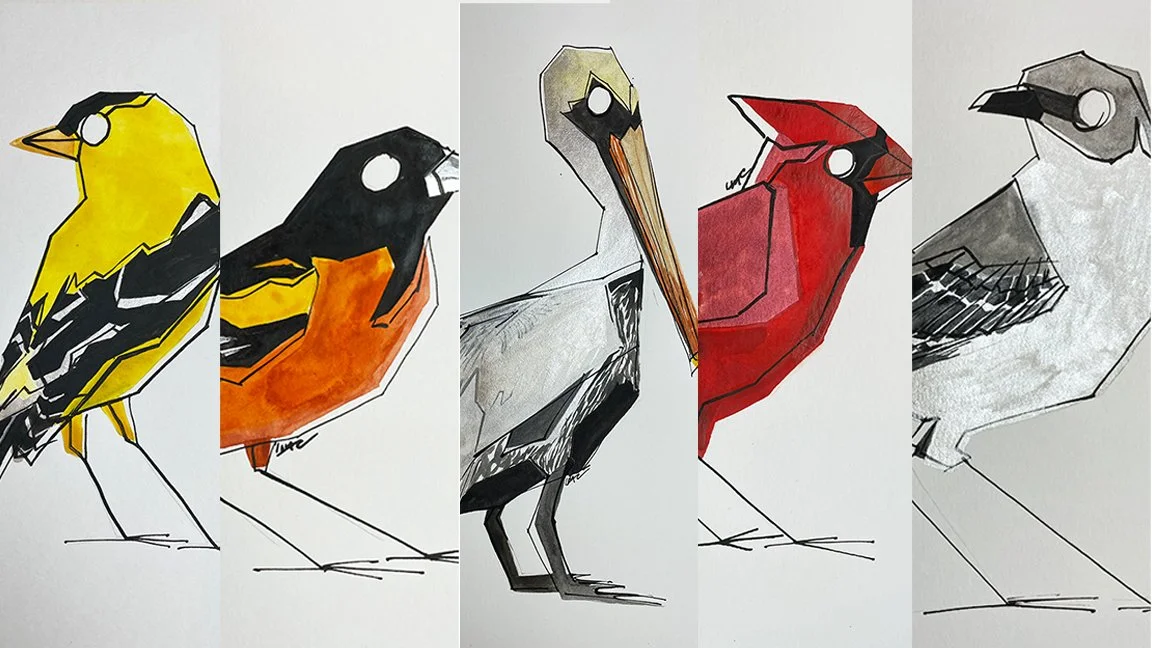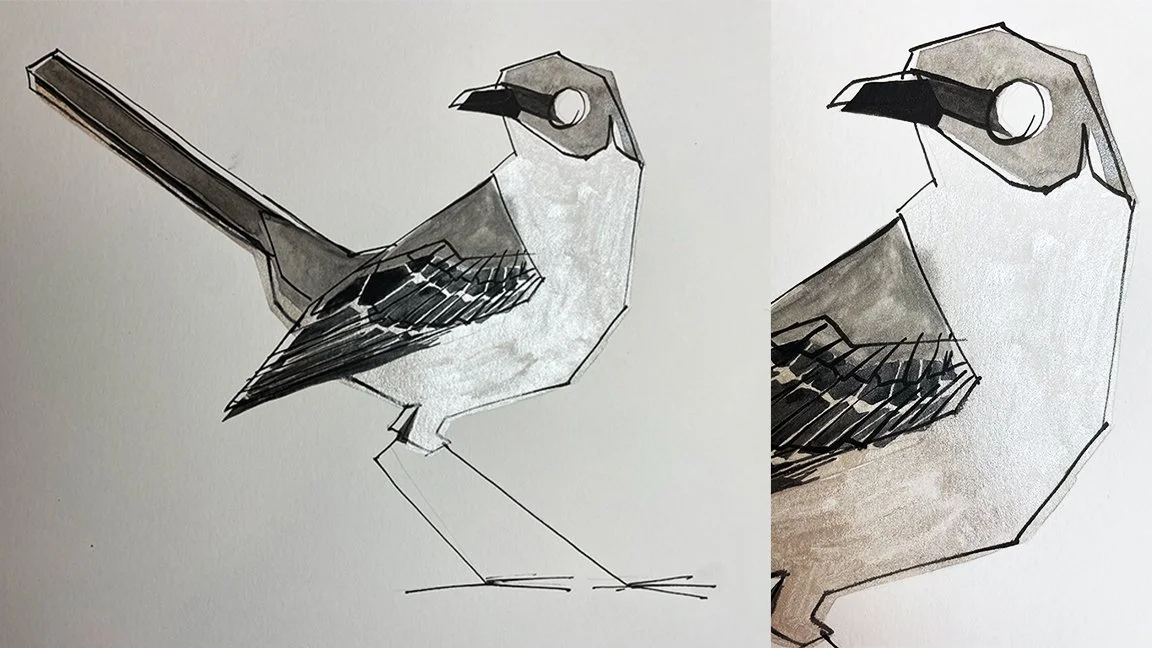The First Five
Northern Cardinal, Northern Mockingbird, American Goldfinch, Brown Pelican and the Baltimore Oriole
Northern Cardinal
The cardinal is likely my most painted bird. Until my most rendition for the state bird portion of my painting project to watercolor every single bird on the continent of North America I had been woefully unhappy with the previous depictions. This guy feels correct, hopefully this will be the last time I formally paint a Northern Cardinal.
Reining champion when it comes state birds representing North Carolina, Virginia, West Virginia, Kentucky, Ohio, Illinois and Indiana a comical lack of originality but who can blame them the Cardinal is an absolute Queen. One of my favorite things about the Northern cardinal is how many times he’s depicted with other males on home decor. Nary a female in sight even when he’s pictured on a Valentine’s Day card. I protested this choice by painting a pair of lesbian cardinals for a friend once. Come to think of it maybe I’ve just thought of my next pride collection…
Found throughout eastern and central North America. Male northern cardinals are known for their bright red plumage and distinctive crest on their heads. The female northern cardinal has a more subdued appearance, with reddish-brown feathers and a crest that is less prominent than the male’s. Often overlooked for their “muted” color scheme I personally find the pattern of the female cardinal to be far more interesting than the male. Northern cardinals are often found in wooded areas, suburban gardens, and parks. They are omnivorous and feed on a variety of seeds, fruits, insects, and small vertebrates.
Did you know the bright red coloration of male northern cardinals is because of what they eat? Cardinals go after foods high in pigments called carotenoids, such as red berries and insects. Northern cardinals are also some of the most involved parents in the featured world. They’re one of the few bird species that can transmit their songs to their offspring before they hatch, allowing the chicks to learn the songs while still in the egg. In some areas, male northern cardinals have been observed feeding and caring for young birds that are not their own, a behavior known as alloparenting.
Northern Mockingbird
Growing up I had a comical number of encounters with the Northern Mockingbird. There were trees that dotted the path between my parent’s house and my aunt’s & Uncles. The trees were absolutely littered with mockingbirds. They would dive aggressively at anyone who dared to walk the path. I used to watch my cat lay and wait trying to catch one when they would dive at him. He never managed to catch one they were far too skilled at flying just close enough to be wildly irritating.
The northern mockingbird is a medium-sized songbird found all over the continent of North America. They are known for their comical ability to mimic the songs and calls of other bird species, as well as sounds from other sources, such as car alarms and cell phone ringtones. Decorated with a grayish-brown plumage, a long tail, and a distinctive white patch on its wings that is visible in flight. They are often found in open habitats such as suburban areas, parks, and gardens, where they feed on a variety of insects, fruits, and seeds. Northern mockingbirds are highly territorial and will aggressively defend their breeding territories, attacking anyone (even humans) who dare to enter their territory.
Northern mockingbirds have an insane range of sounds they can imitate from barking dogs and meowing cats to machinery and other non-natural sounds. They are one of the few bird species that can recognize themselves in a mirror, indicating a high level of cognitive ability. During breeding season, male mockingbirds prove themselves absolutely relentless and occasionally sing all night long, a behavior known as "singing in the dark," which is thought to be a way to establish and defend their territory.
American Goldfinch
The American goldfinch is a small songbird found throughout North America, from southern Canada to northern Mexico. They are known for their bright yellow plumage and black and white wings, which make them a favorite among birdwatchers. American goldfinches are often found in open fields, meadows, and gardens, where they feed on a variety of seeds, including thistle, sunflower, and dandelion. They are one of the latest breeding birds in North America, with nesting activity peaking in July and August. American goldfinches undergo a complete molt each year, with males losing their bright yellow feathers in the fall and regaining them in the spring.
The American goldfinch is the state bird of New Jersey, Iowa, and Washington. Unlike most songbirds, American goldfinches delay building their nests until late summer, when thistles and other plants are producing seeds for them to feed their young. American goldfinches have been observed bathing in the sap of broken tree branches, which is thought to provide them with essential nutrients such as calcium and sugar.
Brown Pelican
The brown pelican is a large water bird found along the Atlantic, Pacific, and Gulf coasts of the Americas. They are known for their distinctive long bill with a stretchy throat pouch, which they use to scoop up fish from the water. Brown pelicans have a dark brown plumage with white head and neck feathers, and their wingspan can reach up to 7 feet. They are the only pelican species that can plunge-dive into the water from heights of up to 60 feet to catch their prey. Brown pelicans were severely threatened by the pesticide DDT in the mid-20th century, which caused their eggs to have thin shells and break easily. However, conservation efforts have helped to bring their populations back to healthy levels.
Brown pelicans have a unique adaptation, they have a gland above their eyes that helps them filter out salt from their bloodstream and then expel it through their nostrils. I guess that's pretty fancy for a bird. And get this, the oldest recorded brown pelican lived to be over 43 years old. Seems as though they have a lot of time to perfect their "fish-stealing" techniques from other birds like cormorants and gulls. They chase these other birds mid-air and make them drop their catch? Talk about a real thief in the sky!
Baltimore Oriole
I’ve always been a little obsessed with the Baltimore Oriole. I mean come on, the color scheme is one giant spooky season salute. My most adored time of the year.
A brightly colored songbird found in eastern and central North America. They are known for their vibrant orange plumage and black wings, and the male has a distinctive black and orange pattern. Baltimore orioles are migratory birds, spending their breeding season in the eastern United States and Canada and wintering in Central America and northern South America. They are primarily insectivorous, but also feed on nectar and fruits, especially during migration. Baltimore orioles are known for their intricate hanging basket nests, which they weave from plant fibers and grasses, and suspend from the outer branches of trees.
Baltimore orioles beaks allow them to probe flowers for nectar. They have a brush-tipped tongue that they can extend into the flower to collect the sweet liquid. Once a status symbol in the 18th and 19th centuries because of their brightly colored plumage. They were often kept as caged birds and even appeared on china patterns and other decorative objects. Male Baltimore orioles have been known to sing more quietly and in a higher pitch in areas where they are surrounded by loud urban noise. This is thought to help them communicate more effectively in noisy environments.
Made it this far? Have a fun fact treat…
Northern cardinal: While the bright red coloration of male Northern Cardinals is well-known, not all males have this coloration. Some males may be yellow or orange, while others may be a mix of red, orange, and yellow.
Northern mockingbird: Mockingbirds are known to collect a variety of materials to build their nests, including twigs, grasses, and bits of paper. But in urban areas, they have been observed picking up cigarette butts and incorporating them into their nests. While this behavior may seem strange, it's actually quite practical - the cellulose acetate in cigarette filters has been found to repel some parasites, helping to keep the nest clean and healthy for the baby birds.
American goldfinch: during the winter, their feathers can actually turn white due to a lack of pigmentation! This is called "leucism," and it's a genetic condition that affects the coloration of feathers. So if you see a white bird at your birdfeeder during the winter, it might just be a goldfinch with a case of leucism.
Brown pelican: Brown pelicans have an unusual way of catching fish. They will fly over the water and then plunge headfirst into the water to catch fish with their bills. However, they don't actually use their eyes to locate the fish – instead, they use their keen sense of smell to detect the fish underwater.
Baltimore oriole: Baltimore orioles are known for their bright orange plumage, but they weren't always this color. In fact, the first recorded description of the bird in 1671 described it as being "chestnut-colored." It's thought that the orange coloration developed as a result of selective breeding by female orioles, who prefer males with brighter and more vibrant colors.










